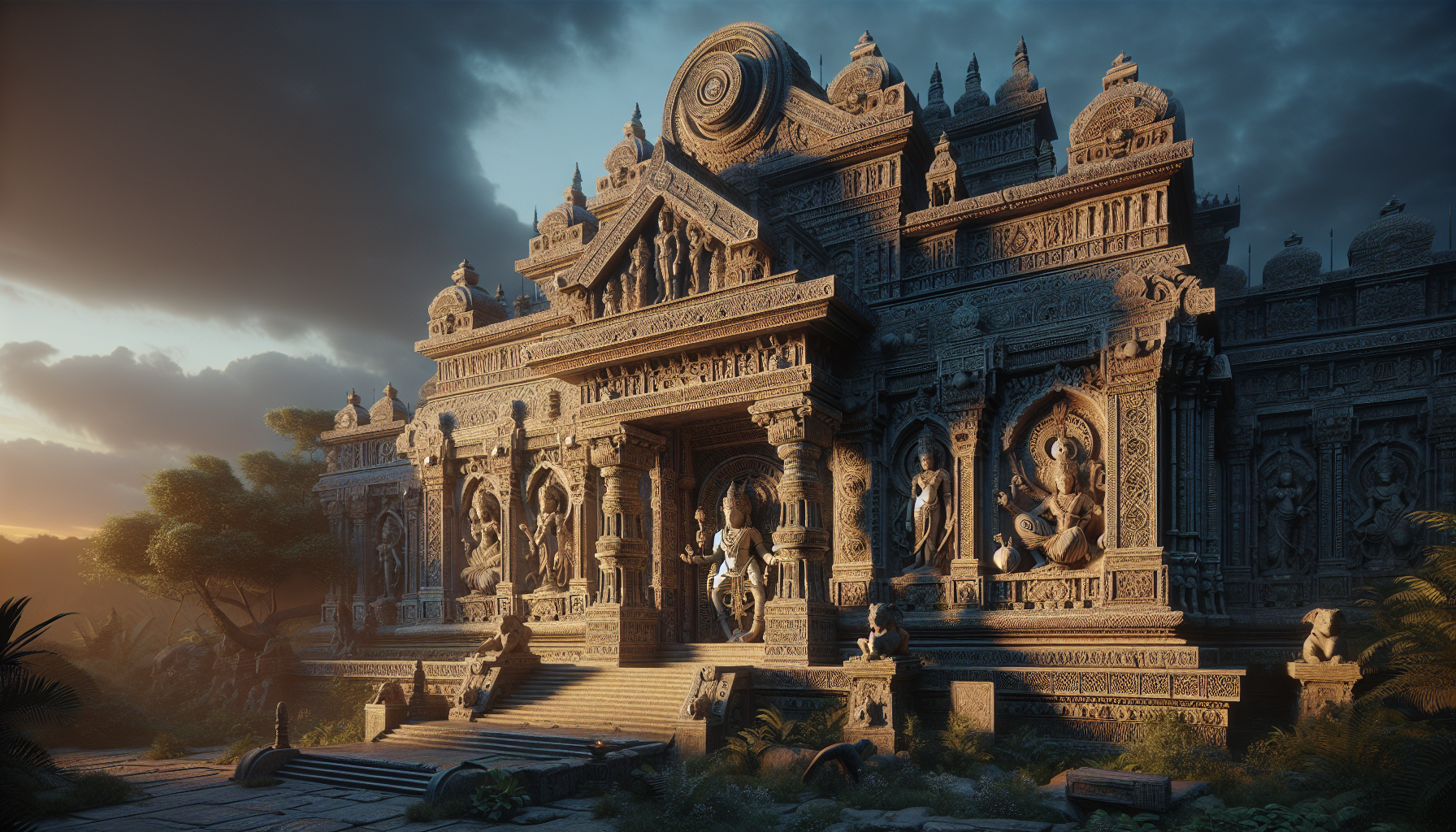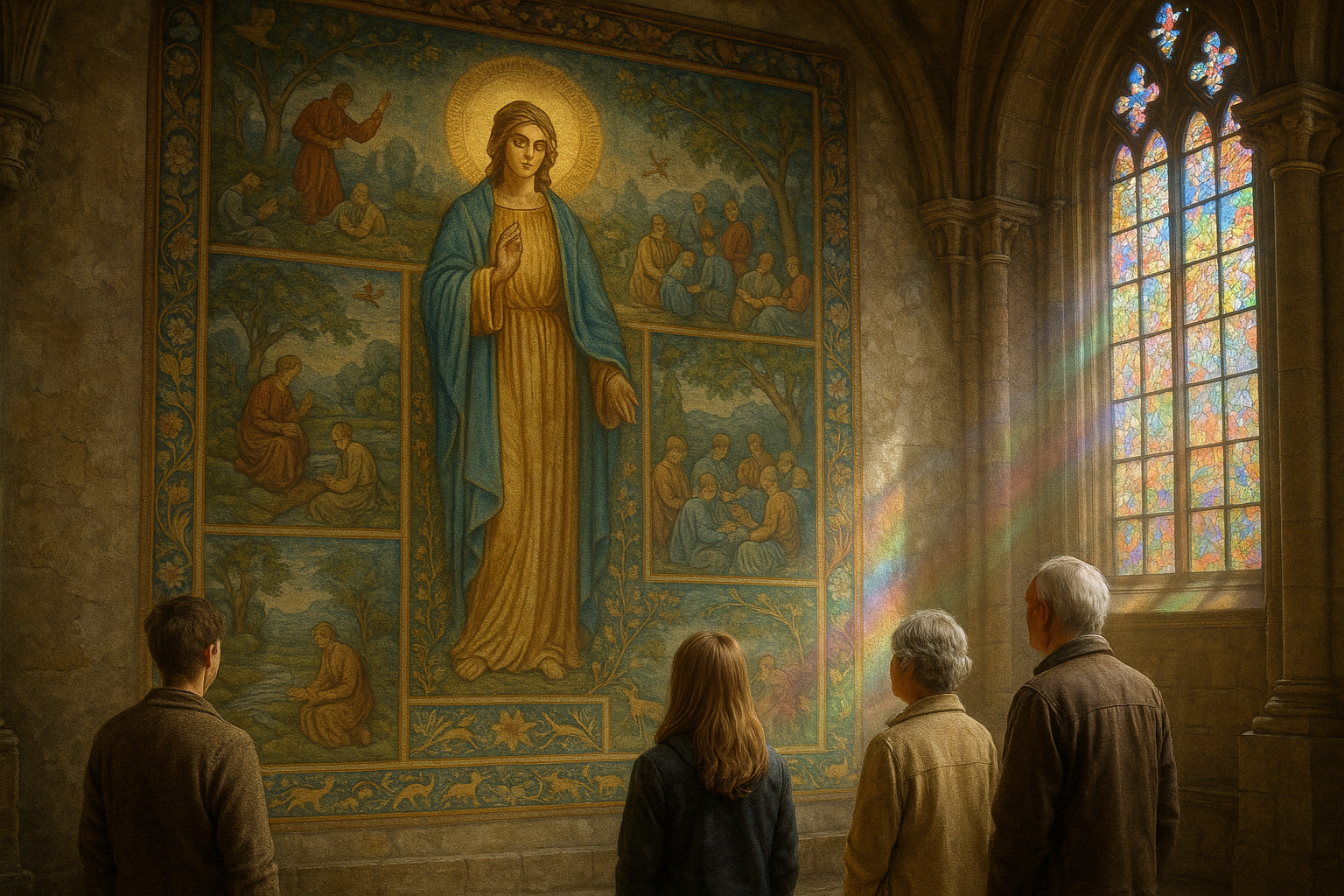In the heart of ancient civilizations, where time seems to whisper secrets of bygone eras, temples stand as monumental testaments to human devotion, artistry, and philosophical inquiry. These sacred structures, with their towering spires and intricate carvings, are more than mere edifices of stone and wood; they are profound symbols imbued with meaning and intent. Welcome to “Shadows of Significance: Unveiling the Symbolism Behind Temple Design,” a journey that will delve into the enigmatic language of architecture and the stories temples silently tell.
For centuries, temples have been the focal points of spiritual life across cultures, serving as bridges between the earthly and the divine. But beyond their religious functions, temples are meticulously designed to embody complex cosmologies and philosophical principles. Every element, from the temple’s orientation to its ornate reliefs, is carefully crafted to convey profound narratives and universal truths. As we explore these sacred spaces, we uncover layers of meaning that reflect the cultural, historical, and spiritual contexts from which they emerged.
Consider the majestic Angkor Wat in Cambodia, whose architecture mirrors the Hindu concept of Mount Meru, the axis of the universe. Its vast complexes and towering central tower symbolize the cosmic mountain, while the surrounding moats and galleries depict oceans and the realms of gods and demons. This intricate symbolism is not unique to Angkor Wat; it is a common thread that runs through temple designs worldwide, from the ziggurats of Mesopotamia to the pagodas of East Asia. Each structure is a canvas upon which civilizations have painted their visions of the universe, encapsulating their beliefs and worldviews.
In this exploration, we will unravel the threads of symbolism woven into temple architecture across different cultures and eras. We will examine how the ancient Egyptians used the play of light and shadow in their temple designs to symbolize the journey of the sun god Ra. We will venture into the sacred geometry of Greek temples, where mathematical precision and harmony reflect the pursuit of balance and order. The journey will also take us to the heart of Indian temple architecture, where every stone tells a story of gods, mortals, and the cosmos.
By the end of our exploration, you’ll gain a deeper appreciation for the artistry and intellect that underpins these timeless structures. Temples are not merely places of worship; they are repositories of human knowledge and creativity, offering insights into the minds and souls of the people who built them. Join us as we peel back the layers of history and symbolism, revealing the hidden messages carved into the very stones of these sacred monuments. 🕌 As we shine a light on these shadows of significance, prepare to see temples in a way you’ve never seen before—through the lens of symbolism and meaning that transcends time and culture.
Understanding the Significance of Temple Design
Temple design is a fascinating subject that merges art, architecture, culture, and spirituality. Throughout history, temples have served as the heart of religious and community life, embodying the beliefs and values of their respective societies. The architecture of these sacred spaces often reflects profound symbolism, with every element contributing to a larger narrative. From the majestic pyramids of Egypt to the ornate pagodas of Asia, each temple tells its own story, unveiling a tapestry of cultural significance. This article delves into the intricate symbolism embedded in temple design, exploring how these structures transcend mere physical form to embody deeper meanings.
One of the most intriguing aspects of temple design is its ability to represent cosmology and the spiritual world. Many temples are built with specific orientations and alignments that mirror celestial phenomena. For example, ancient Egyptian temples were often aligned with the sun or stars, symbolizing a connection between the earthly and divine realms. Similarly, Hindu temples are designed to represent Mount Meru, the mythical axis mundi in Hindu cosmology. This symbolic representation reinforces the temple’s role as a bridge between humans and the divine, offering a space for spiritual reflection and connection.
In addition to cosmological symbolism, temple architecture often incorporates elements that represent fundamental aspects of human existence. Temples frequently embody the principles of balance and harmony, reflecting the belief that these qualities are essential for spiritual enlightenment. For instance, the symmetry and proportion found in many temple designs are not merely aesthetic choices but deliberate expressions of universal harmony. The use of sacred geometry further emphasizes this theme, with geometric patterns and shapes symbolizing the interconnectedness of all life. As you explore temple design, you begin to see how these structures serve as metaphysical maps, guiding individuals on their spiritual journeys.
The Role of Symbolism in Temple Architecture
The symbolism inherent in temple architecture is a testament to the profound thought and intention behind these sacred spaces. Each architectural element serves a specific purpose, contributing to the overall narrative conveyed by the temple. The use of symbolism in temple design is not limited to any one culture or religion but is a universal phenomenon observed across the globe. This section explores some common symbolic elements found in temple architecture, offering insights into their meanings and significance.
A common symbolic element in temple design is the use of thresholds or gateways. These architectural features often signify the transition from the mundane world to the sacred space within the temple. In many cultures, the entrance to a temple is marked by an elaborate gateway, adorned with intricate carvings and motifs. This threshold serves as a symbolic barrier, delineating the boundary between the physical and spiritual realms. As visitors cross this threshold, they are encouraged to leave behind worldly concerns and enter a space of contemplation and devotion.
Another prevalent symbolic feature in temple architecture is the use of towers or spires. These vertical structures often represent the ascent toward the divine, symbolizing the soul’s journey to enlightenment. In Hindu temples, for example, the tower or ‘shikhara’ is often the tallest part of the temple, reaching skyward as a symbol of spiritual aspiration. Similarly, in Gothic cathedrals, the spires point towards the heavens, serving as a visual reminder of the divine presence. These towering structures not only add to the grandeur of the temple but also reinforce its spiritual significance.
Symbolic Elements and Their Meanings
- Thresholds/Gateways: Represent the transition from the secular to the sacred.
- Towers/Spires: Symbolize the soul’s journey towards enlightenment.
- Columns/Pillars: Often represent stability and support, both physically and spiritually.
- Domes: Symbolize the heavens or the vault of the sky.
Comparative Analysis of Temple Designs Across Cultures
The diversity of temple designs across cultures offers a fascinating glimpse into the ways different societies express their spiritual beliefs through architecture. While the fundamental purpose of a temple as a place of worship remains consistent, the architectural styles, materials, and symbolic elements can vary significantly. This section presents a comparative analysis of temple designs from different cultures, highlighting the unique characteristics and shared themes that define these sacred spaces.
| Culture | Architectural Style | Symbolic Elements |
|---|---|---|
| Western (Gothic Cathedrals) | Verticality, light, stained glass | Spires, arches, rose windows |
| Eastern (Buddhist Stupas) | Rounded forms, intricate carvings | Stupas, mandalas, lotus motifs |
Despite these differences, there are also striking similarities in the symbolic elements found in temples across cultures. For instance, the use of columns or pillars as symbols of stability and support is a common feature in many temple designs. Whether in the form of the Doric columns of ancient Greece or the ornate pillars of Hindu temples, these structural elements convey a sense of strength and permanence. Additionally, the incorporation of water features, such as pools or fountains, is another universal theme, symbolizing purification and the flow of life.
Modern Interpretations of Temple Symbolism
While traditional temple designs continue to inspire awe and reverence, modern interpretations of temple symbolism offer fresh perspectives on spiritual architecture. Contemporary architects and designers are reimagining temples, blending traditional elements with innovative concepts to create spaces that resonate with today’s spiritual seekers. This section explores some of these modern interpretations, highlighting how they incorporate and reinterpret traditional symbolism.
One notable trend in modern temple design is the emphasis on sustainability and environmental consciousness. Many contemporary temples are designed with eco-friendly materials and practices, reflecting a growing awareness of the interconnectedness of all life. This emphasis on sustainability can be seen as an extension of traditional symbolic themes, such as balance and harmony, applied to the modern context. By integrating natural elements and sustainable technologies, these temples embody a holistic approach to spirituality that honors both the earth and the divine.
Another modern interpretation of temple symbolism is the use of minimalism and simplicity in design. In contrast to the ornate and intricate decorations of traditional temples, some contemporary designs favor clean lines and open spaces. This minimalist approach allows the symbolism of the temple to emerge through its form and function, rather than through elaborate ornamentation. By stripping away excess, these modern temples invite visitors to engage with the essence of spirituality, fostering a sense of peace and reflection.
Innovative Temple Designs
- Sustainable Materials: Incorporating eco-friendly materials and practices.
- Minimalist Aesthetics: Emphasizing simplicity and open spaces.
- Interactive Elements: Engaging visitors through technology and interactive design.
In addition to these trends, some modern temples incorporate interactive elements that engage visitors in new ways. Technology is being used to create immersive experiences, such as interactive light displays and soundscapes, that enhance the spiritual atmosphere. These innovations reflect a desire to make spirituality accessible and relevant to contemporary audiences, bridging the gap between ancient traditions and modern sensibilities.
The evolution of temple design continues to reflect the changing needs and values of society. By embracing new ideas and technologies, modern temples are reimagining traditional symbolism in ways that resonate with today’s spiritual seekers. Whether through sustainability, minimalism, or interactivity, these contemporary designs offer fresh insights into the timeless quest for meaning and connection with the divine.
For a visual exploration of the rich symbolism in temple design, watch this engaging video: “Symbolism in Temple Architecture” by Architecture Insights. 🌟

Conclusion
Conclusion: Unveiling the Symbolism Behind Temple Design
As we conclude our exploration of the profound topic, “Shadows of Significance: Unveiling the Symbolism Behind Temple Design,” it becomes evident that the architectural choices and aesthetic elements of temples around the world are far from arbitrary. Each curve, line, and detail carries a weight of meaning and intent, offering insight into the cultures and beliefs that crafted them.
Firstly, we delved into the historical context of temple design, highlighting how these structures serve as physical manifestations of spiritual ideologies. The article illustrated how temples, such as the Parthenon in Greece and Angkor Wat in Cambodia, not only reflect the religious practices of their time but also represent the socio-political climates that influenced their construction. Understanding this context enriches our appreciation for these monuments beyond their aesthetic grandeur.
Secondly, the symbolism embedded within temple architecture was examined. Temples often incorporate sacred geometry and alignments that mirror celestial events or embody cosmological principles. For example, the layout of the Egyptian pyramids aligning with Orion’s Belt or the intricate carvings in Hindu temples depicting stories from their scriptures reveal a deliberate intertwining of earthly and divine realms. These design elements invite us to ponder the deeper connections between humanity and the cosmos.
Moreover, the article highlighted the role of temples as community centers. Beyond their spiritual purposes, temples have historically been places of gathering, education, and cultural preservation. This dual role emphasizes the temple’s significance as both a spiritual sanctuary and a hub of social interaction, reflecting the integral role religion and spirituality play in fostering community cohesion.
Importantly, the discussion also addressed the modern implications of temple design. In a rapidly globalizing world, the preservation and appreciation of these cultural treasures take on new urgency. As custodians of our shared heritage, it is incumbent upon us to protect and cherish these sites, ensuring they continue to inspire and educate future generations.
In conclusion, the study of temple design is not just an exploration of ancient architecture but a journey into the hearts and minds of those who built them. Each temple tells a story, whispering secrets of the past while challenging us to reflect on our present and future. As we decode the symbolic language of these sacred spaces, we gain insights into universal human experiences and aspirations.
To further your understanding of this fascinating topic, consider exploring additional resources such as “The Art and Architecture of Ancient Greece” by Judith Barringer [available here](https://www.cambridge.org/), or “The Symbolism of Hindu Gods and Rituals” by A. Parthasarathy [available here](https://www.amazon.com/). These works provide deeper dives into the intricacies of temple symbolism and design across different cultures.
We encourage you to engage with this content by sharing your thoughts in the comments below or discussing it with friends and family. Sharing knowledge helps keep these cultural narratives alive, ensuring that the wisdom of the past continues to resonate today. If you found value in this exploration, don’t hesitate to share it within your networks 🌍.
By appreciating the shadows of significance cast by temple designs, we embark on a journey not just of discovery, but of connection—to the past, to each other, and to the myriad expressions of human creativity and faith. Let us cherish and celebrate these architectural wonders, allowing their enduring legacy to inspire and enlighten.
Toni Santos is a visual storyteller and sensory artisan whose work explores the ancient aesthetics of the senses—how early cultures designed their environments not just for function, but for emotional, spiritual, and sensory harmony. Through thoughtful visual interpretations, Toni revives a world where every texture, scent, color, and sound was part of a deeper design for inner balance.
Guided by a passion for the subtle intelligence of ancient spaces—from meditative gardens to sacred interiors—Toni’s creations reflect the intentional artistry once used to align body, spirit, and surroundings. Whether studying the calming patterns of Mesopotamian textiles or the acoustic geometry of forgotten sanctuaries, his work invites modern audiences to rediscover the sensory wisdom of the past.
With roots in handcrafted design and symbolic research, Toni brings together material culture, ritual aesthetics, and environmental intuition. His art does more than depict—it restores a dialogue between the senses and the soul, rooted in time-tested principles of well-being.
As the guiding force behind Vizovex, Toni shares curated visuals, reflective essays, and timeless design stories that invite others to reconnect with the aesthetic languages of ancient harmony.
His work is a tribute to:
The sensory intelligence of ancestral environments
The use of beauty as a tool for spiritual and emotional balance
The ancient belief in harmony between people, nature, and space
Whether you’re a designer, a historian, or a seeker of inner stillness, Toni welcomes you into a world where the senses are sacred, and where ancient beauty whispers through space, rhythm, and form—one texture, one echo, one breath at a time.





